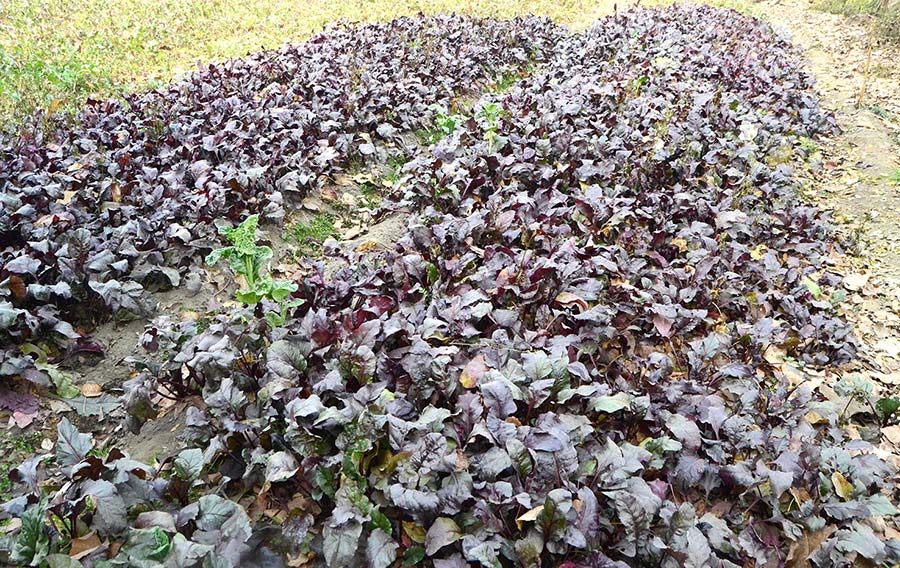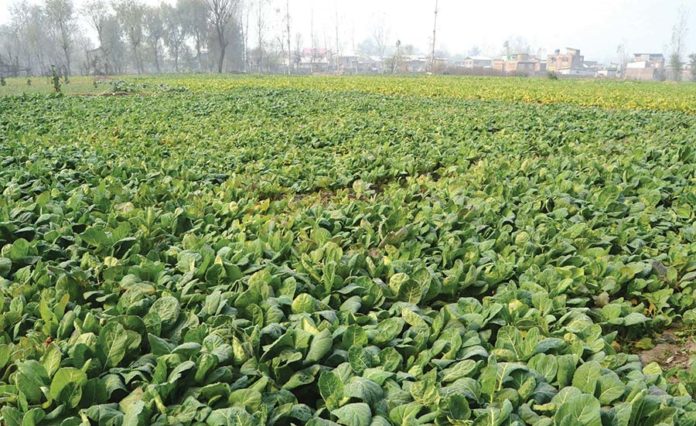A severe shortage of haakh, a staple leafy green in Kashmiri cuisine, has left residents grappling with soaring prices and reduced supply. The shortage, caused by disease infestation and climatic conditions this summer, has led to prices skyrocketing, surpassing the price of chicken, writes Babra Wani
A couple of weeks ago, Shahid was asked by his mother to buy haakh—a staple leafy green—from a nearby vegetable seller. Shahid set out gladly, only to find, to his dismay, that the vegetable was unavailable. Upon inquiry, the seller informed him that production had been affected, leading to a shortage.
“We have our kitchen garden, but we were not able to produce any vegetables this year because of various reasons,” Shahid explained. “So, when my mother craved haakh, I went to buy it, but the seller did not have any. He informed me that the production was very low and that whatever he had was already sold out. The price has also increased,” he added, stressing that the rise in cost is due to reduced supply. “The vegetable seller told me that some kind of disease had affected the productivity of the vegetable.”
For over two months now, residents across Kashmir have been grappling with the unavailability of vegetables in local markets. Many, particularly from rural areas, report that their crops, especially haakh (knol-khol), have been severely affected by saeyi, a type of pest infestation prevalent in leafy vegetables.
“We expected a high yield of haakh this year,” said a resident of South Kashmir, who maintains a kitchen garden. “But the vegetable got affected, and this issue is widespread. I even discussed it with friends and family from other areas, and they all said the same thing: haakhis not growing well.”
Soaring Prices
In the face of a severe shortage of the staple vegetable haakh, prices have skyrocketed across Kashmir. “Initially, we used to buy haakh for Rs 30 , but a few days ago a vendor sold it to us for Rs 100. Even haakh has become a luxury now; it used to be the food of the masses,” said Shabnam, a resident of Chanapora. “We cooked it almost every two days because it is a staple in our households. There were times when we discarded leftovers, but now we savour every leaf. My mother and sister used to send me haakh in sacks from the village, but this year even they are disappointed.”
Nasir, a resident of Kulgam, shared his own experience. “We grow haakh for our domestic use on half a Kanal of land. We do not sell it; we just distribute it among the family. But this year, we could not produce any haakh due to two reasons: disease infestation and climatic conditions. We managed to grow a few plants, but they were affected by the disease, and later the weather also played its part.”
Haakh, also known as collard greens, is a staple in Kashmiri cuisine. It is currently selling for an astounding Rs 120 per kilogram, surpassing the price of chicken, which is Rs 115 per kilogram.
A vegetable seller in the Baghimehtab area of Srinagar explained the situation. “It is not just haakh, but potatoes and other vegetables as well that are in high demand. The shortage and rising demand are driving up prices, and even for us, it has become difficult to procure them.”
The Expert Take
Dr Mudasir Gani Bhat, Assistant Professor at the Division of Entomology, SKUAST-K, linked the current vegetable crisis to a rise in insect and pest outbreaks. “The increase in temperature due to climate change has accelerated the growth and reproduction rates of insects and pests, leading to more generations and larger populations,” Bhat noted. “This trend has resulted in a decline in productivity and production overall, affecting crops like haakh, cauliflower, and cabbage the most. In Narkarah, Budgam, a high infestation of the diamond-back moth has caused severe damage to vegetable production. We have implemented management strategies to combat this. Aphids affecting Kashmiri haakh are also on the rise, impacting both vegetables and apple orchards.”
Bhat asserted the need for an integrated pest management (IPM) strategy. “If you plan to sow a vegetable crop, you should also plant a trap crop about twenty days in advance to attract and trap pests. Another method is pheromone trapping, which targets adult male pests and prevents them from mating. Monitoring the number of trapped insects helps gauge the infestation level,” he said. “We also recommend spraying with natural extracts like NSK, Neem Azal T, and Neemix every 15 days to combat infestations. These methods are safe and suitable for organic farming. As temperatures rise, so does the infestation and geographical spread of pests,” he added.

Vegetable Market in Kashmir
In Kashmir, regions such as Bugam, Tengpora, Bakshipora, Maloora, and Noorbagh are known for their vegetable production, supplying markets with staples like capsicum, tomatoes, radishes, and brinjals.
In 2022, vegetable production in Jammu and Kashmir reached 1,995 thousand metric tonnes, marking a 33 per cent increase over the previous three years, claims the Kashmir Agriculture Directorate. The area of cultivated land expanded significantly, from 60,000 hectares in 2019 to 84,000 hectares in 2022.
Year 2020, recorded 1,339 thousand metric tonnes of vegetable production, reflecting a one per cent increase over 2019. By 2021, output rose to 1,890 thousand metric tonnes, with the area under cultivation reaching 84,000 hectares annually.
Department of Agriculture data suggests that Budgam district stands as Kashmir’s leading vegetable producer. During the Kharif season, it yields approximately 175 tonnes of vegetables, accounting for 25 per cent of the 700 tonnes produced across the Kashmir region.


